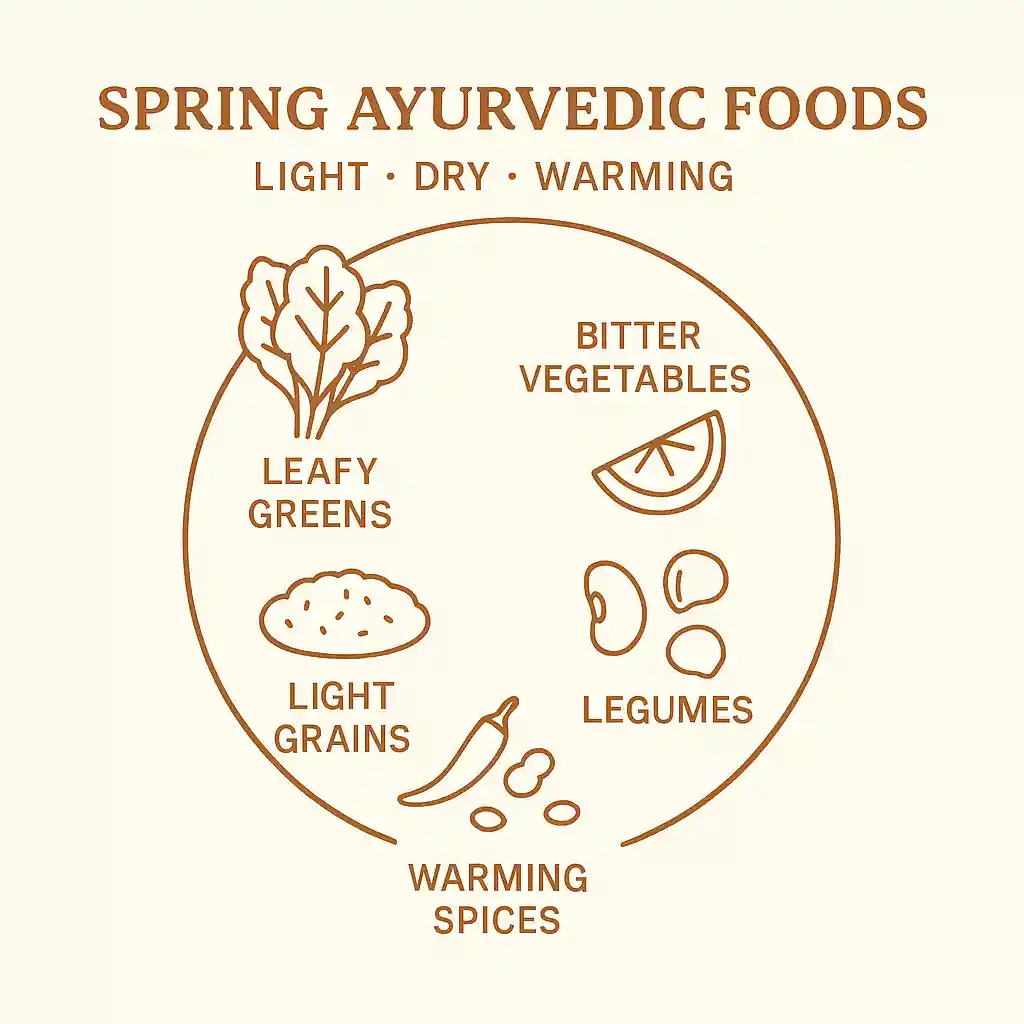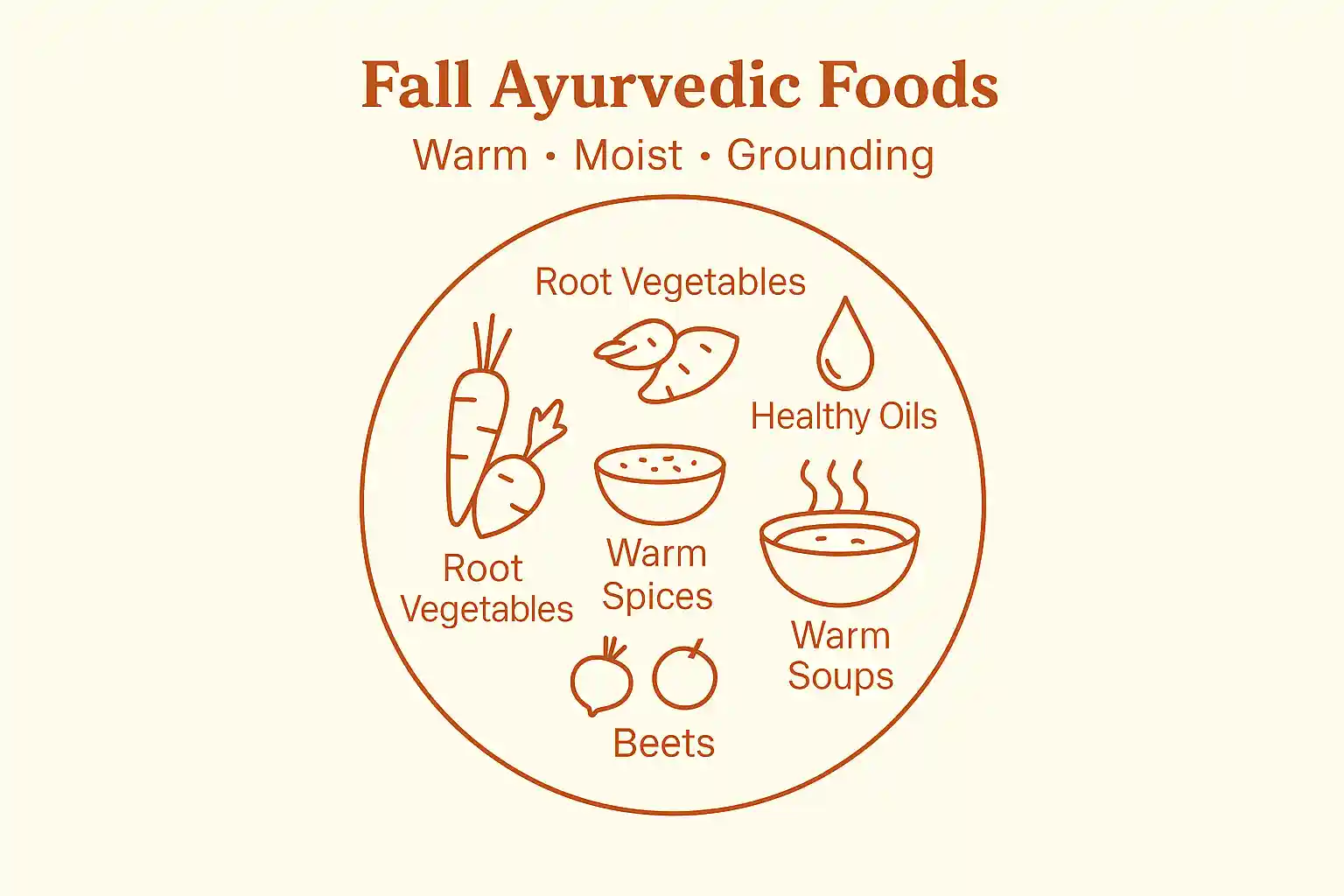Winter brings cold, heaviness, and stillness—qualities that challenge both Vata and Kapha doshas. An Ayurvedic winter diet helps you build strength, stimulate digestion, and fortify your immunity during this introspective season.
Understanding Winter in Ayurveda: Hemanta to Shishira
In Ayurvedic seasonal theory (Ritucharya), winter spans two seasons:
- Hemanta Ritu (early winter) – mid-November to mid-January
- Shishira Ritu (late winter) – mid-January to mid-March
In Hemanta, the external cold draws internal heat deep into the body, making Agni (digestive fire) strongest. This is the season for deep nourishment, tissue building (Dhatu formation), and Ojas replenishment.
By Shishira, Kapha begins to dominate more fully due to lingering cold and moisture, potentially leading to congestion, heaviness, and stagnation.
Dosha Dynamics in Winter
- Vata remains elevated in early winter due to dryness and cold
- Kapha begins accumulating by late winter due to cold, heaviness, and dampness
Common Imbalances in Winter:
- Vata: dry skin, stiff joints, anxiety, insomnia, digestive irregularity (learn about foods that aggravate Vata)
- Kapha: congestion, sluggish digestion, weight gain, dull mood, constipation
Key principle: "Nourish and stimulate." Build strength without letting Kapha stagnate.
Ayurvedic Winter Eating Guidelines
Favor
- Warm, oily, cooked meals
- Spices that enhance Agni
- Sweet, sour, and salty tastes
- Heavier proteins and complex carbs (especially in Hemanta)
Avoid
- Cold or raw foods
- Iced beverages
- Excess dairy, fried foods, and heavy sweets (especially in Shishira)
Best Foods to Favor in Winter
Vegetables
- Root vegetables (carrots, beets, parsnips, turnips)
- Squash (butternut, pumpkin)
- Onions, garlic
- Cooked leafy greens, Brussels sprouts
Fruits (stewed or cooked)
- Apples, pears, berries
- Pomegranates, oranges (moderation), grapes
Grains
- Basmati or brown rice
- Cooked oats
- Quinoa, amaranth
Legumes
- Lentils
- Mung beans
- Split peas
Oils & Fats
- Ghee
- Sesame oil
- Olive oil
Spices
- Ginger, cinnamon, turmeric
- Black pepper, cumin, mustard seed
- Cardamom, cloves
Beverages
- Warm lemon water
- Ginger or CCF tea
- Spiced milk (with cardamom, nutmeg)
Foods to Reduce or Avoid in Winter
- Cold/raw foods: salads, smoothies, iced drinks
- Heavy dairy: cheese, ice cream
- Fried/greasy foods: promote Kapha buildup
- Excess sweets: dampen Agni and increase lethargy
Sample Winter Meals
Breakfast
- Spiced oatmeal with cooked apples, raisins, and ghee
- Rice pudding with cardamom and nutmeg
Lunch
- Root vegetable soup with lentils and turmeric
- Brown rice with sautéed greens and roasted squash
Dinner
- Mung bean dal with cumin and ghee
- Quinoa with roasted root veggies and warming tahini dressing
Throughout the Day:
- Ginger tea, warm lemon water, spiced milk at night
Personalizing Winter Eating by Dosha
Vata-Predominant
- Follow winter guidelines closely
- Prioritize oil, warmth, grounding meals
- Maintain routine and rest
Kapha-Predominant
- Focus on stimulation and lightness
- Use pungent spices (ginger, mustard, black pepper)
- Eat lighter in Shishira to prevent buildup
Pitta-Predominant
- Can tolerate heavier, nourishing meals
- Use spices moderately (avoid overheating)
- Balance comfort with digestive ease
Signs You May Need Adjustment
Vata Imbalance:
- Dryness in skin or joints
- Cold extremities
- Insomnia or anxious mind
Kapha Imbalance:
- Sluggish digestion
- Mucus, sinus congestion
- Low mood or heaviness
Completing the Seasonal Cycle: Winter as a Time of Deep Nourishment
Winter is nature's season of rest and repair. When you embrace warming, oily, and stabilizing foods in Hemanta, you support tissue nourishment, rebuild Ojas, and buffer against Vata depletion. As Shishira approaches, adapt to prevent Kapha stagnation by favoring lighter meals and digestive-stoking practices.
FAQ: Winter Ayurvedic Diet
How to Personalize Your Winter Diet Based on Your Dosha
Your dominant dosha influences how you should approach winter eating:
Vata-predominant
- Prioritize warmth, oils, and grounding foods
- Follow winter guidelines strictly to maintain stability and moisture
Kapha-predominant
- Focus on spice and stimulation → prevent heaviness and stagnation
- Be mindful of portion size → avoid Kapha buildup
Pitta-predominant
- Can enjoy heavier foods in moderation → but still favor warmth over excess spice
- Balance nourishment with digestive comfort
Final Thoughts: Completing the Seasonal Cycle
Winter is a season for nourishment, restoration, and building resilience. By embracing warming, grounding, and moistening foods, you can balance Vata and Kapha, keep digestion strong, and support immunity and vitality through the colder months.
Ayurveda encourages a flexible, intuitive approach — listen to your body, adapt your diet as needed, and honor the unique needs of this season. As winter's deep nourishment sustains you through the coldest months, remember that this season of rest and restoration prepares your body for the renewal that comes with spring.
The seasonal wheel turns continuously, and the warming, grounding practices that serve you in winter will gradually give way to the lighter, cleansing approaches needed as nature awakens again.
Welcome Spring's Renewal
As winter's nourishing practices build your strength and vitality, your body will naturally prepare for spring's cleansing energy. When the time comes, discover how to support your body's natural detoxification process with our comprehensive Spring Ayurvedic Diet Guide and learn the lighter, warming practices that help you emerge from winter refreshed and renewed.
Frequently Asked Questions
Common questions about winter Ayurvedic eating
Related Articles

Ayurvedic Diet for Spring (Kapha Season)
Spring marks a season of renewal and growth, but in Ayurvedic terms, it's also the Kapha season. Learn how to align your diet with spring's energy for optimal vitality and balance.
7 min read
Ayurvedic Diet for Fall (Vata Season)
As autumn arrives with cool winds and crisp air, Vata dosha begins to rise. Learn how to ground your energy, nourish your body, and stay balanced with Ayurvedic dietary guidance for the fall season.
6 min read